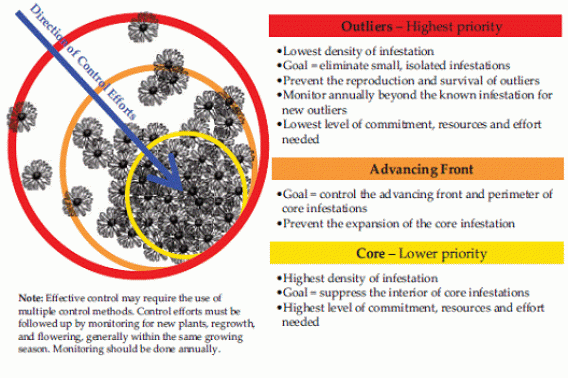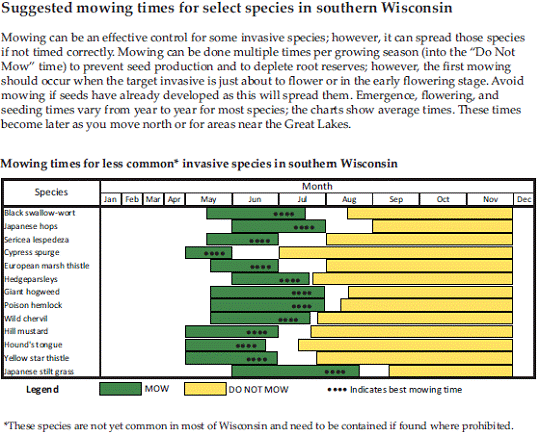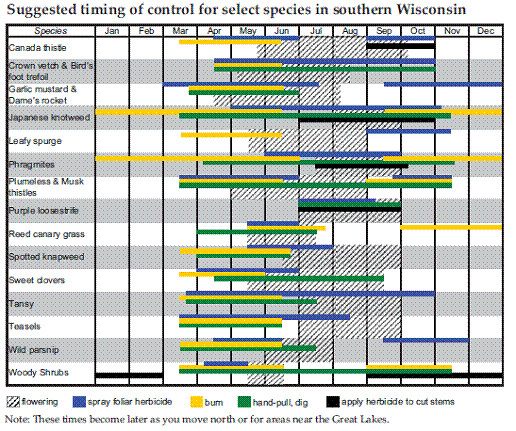The Committee On The Environment And Tree Board is an ad-hoc committee which meets to discuss the deer program, wetlands, trash removal, recycling and other environmental concerns.
Co-Chairman
- John Machulak
- Peter Thornquist
Village Trustee
- Peggy Russo
Members
- Darele Bisquerra
- Larry Boyer
- Linda Ivarson
- Tamara Miller
- Miguel Mireles
- Emily Siegrist
- Anne Vogel
Advisory
- Bob Boucher
- Hadie Purtell
- Wendy Walcott
2020 Agendas & Proclamations
CONTROL METHODS FOR INVASIVE SPECIES
care of: Wisconsin Department of Natural Resources website
- Eradicating invasive species on site is an attainable goal, especially if new introductions are detected early. However, eradication may not be feasible when populations are large and pervasive. When limited resources or the degree of infestation preclude eradication, a more realistic management goal is to control the unwanted species by reducing their density and abundance to a level that does not compromise the integrity of the ecosystem and allows native species to thrive.
Control programs can include manual, mechanical, chemical, biological and cultural components. Landowners and land managers should evaluate their site, the life cycle characteristics of the invasive species and the best available science to determine which control method or combination of methods will be most effective and economical.
Employing a combination of prevention and control measures is an effective way for landowners and land managers to manage invasive species. This approach is often referred to as integrated pest management (IPM) and can include pulling, cutting, targeted pesticide use, biological controls and native species reintroduction.
Where eradication of the invasive species is not realistic, control strategies must strike a balance between the ecological impacts of allowing invasive species to spread and the economic realities of control measures. Not all control methods are practical, effective, economically feasible or environmentally sound for every situation. It’s recommended that landowners and land managers consult the most recent science or refer to invasive species websites.
- MANUAL CONTROL
- Manual control techniques include activities such as hand-pulling, digging, flooding, mulching, burning, removal of alternate hosts and manual destruction or removal of nests, egg masses or other life stages. These techniques work best on small populations or in areas where chemicals or motorized equipment cannot be used.
Manual control efforts must be persistent and several treatments may be needed to reduce or eliminate the target population. If infestations are too pervasive, manual control may become labor-intensive and thus not economically feasible.
- Digging/hand-pulling – Remove the entire root to prevent resprouting. This usually works best with small or young plants, in sandy or loose soils, or when soils are damp.
- Smothering – Use mulch, black plastic, carpet, or any other impenetrable barrier to cover target plants for at least one growing season. The effectiveness of this technique can be increased by first cutting the target plants and then smothering them. If dealing with a species that produces clones, be sure to cover all stems of the species.
- Flooding – This is only feasible where water levels can be manipulated to completely cover cut plants for a period of time. The depth of water necessary and the amount of time cut plants should be covered will vary from species to species.
- PRESCRIBED FIRE
- If using fire as a control technique, know and follow local burning regulations and check local ordinances. Grass or prairie fires can spread rapidly. Consult with natural areas management experts at nature centers, your local DNR office or local land management consultants for training opportunities before attempting this method of control. Burn permits are required in many areas and more information on permits can be attained through local fire departments and the Wisconsin DNR.Under DNR law, anyone found burning without a permit is subject to a $175 fine. Those responsible for starting a wildfire are liable for all suppression costs. This could mean the cost of firefighters, fire trucks, airplanes and even the cost of damage.Also, refer to the Best Management Practices for Invasive Species to reduce the spread of invasive species when preparing for prescribed burns (Chapter 8 of the Forestry BMPs [exit DNR]).Read the Wisconsin DNR Forestry Management Guidelines for a more complete guide of what is needed for a controlled burn to take place (planning, equipment, personal protection).Controlled or “prescribed” burns are used to reduce invasive and woody plant density and competition, stimulate the growth of native plants, return nutrients to the soil, promote germination of dormant seeds and enhance wildlife habitat.These burns are called “controlled” or “prescribed” because they are done only under specific weather-and fuel-related conditions that ensure an effective burn and the safety of the burn crew and the surrounding area. Purposely set in plant communities that have evolved with fire, such as oak woodlands, prairies, savannas and sedge meadows, controlled burns can kill or set back certain invasive species that do not tolerate fire. Burns are usually conducted in mid-spring or fall. If early blooming wildflowers are present, it is often best to burn in very early spring or late fall to avoid damaging them.In natural areas that are badly infested with invasive plants, controlled burns may initially need to be done for several years in a row to reduce the weed seed bank and stimulate native species. Burning this frequently is not generally recommended in healthy native plant communities because important insect pupae and eggs may also be destroyed. Burning one-third to one-half of a natural area each year on a rotating basis is usually the preferred management strategy and will lead to increased plant and insect diversity.Conducting controlled burns should not be taken lightly. Burning is a dangerous activity that requires planning, coordination, equipment and trained personnel. It also requires an understanding of how fuel conditions and weather conditions, such as humidity, temperature, wind direction and wind speed, affect a burn.When utilizing prescribed fire for forest stewardship practices, consider the use of the Fire Effects Information System [exit DNR]. This website offers information regarding how various animal and plant species, including invasive plants, react to fire. It also contains information regarding what intensity of the fire is best for the management of these species.
Another website that may be useful in deciding whether the prescribed fire is a viable management technique is the Nature Conservancy’s Global Invasive Species Team [exit DNR] website. The website features Invasive Plant Species Summaries which give information regarding the management of various invasive species.
Spot treatment with fire: Sometimes large-scale burns are either inappropriate or cannot be done because of high fuel moisture or a lack of fuel to carry a fire. In such situations, spot-treating plants that are vulnerable to fire may be preferred. A propane torch with a long wand works well in these situations and can be used to treat individual plants or small groups of plants.
This technique works especially well on seedlings and young saplings and is generally less labor-intensive than hand-pulling and less expensive than herbicide treatments. Spot burning often only top-kills more mature plants.
To burn invasive plants with a propane torch, the operator passes the flame over the plant for less than one second, which is enough time to boil the water in the plant. Boiling the water within the plant will cause it to droop immediately and die within a couple of hours.
Some municipalities will not allow other types of prescribed burning but will approve burn permits for spot-treating plants with a propane torch. Be aware, however, that propane torches are dangerous to use, and there are several safety hazards that should be observed.
- Wear fire safety gear (Nomex fire suit, hard hat with face shield and Nomex ear/neck protector, leather gloves and leather boots).
- Make sure that the pressure relief valve on top is pointing away from the person carrying the pack. This valve is designed to release pressure by venting gas. If the tank overheats, the vented gas can ignite and will burn the applicator if the valve is pointing inward.
- Always be cautious where you set the torch down because the tip of the torch gets very hot. Cool it down with water, if possible.
- Do not use propane torches on dry vegetation or when windy conditions exist unless you have made adequate preparations to contain a runaway fire.
- MECHANICAL CONTROL
- Mechanical control techniques include hoeing, cutting, girdling, tilling, mowing, chopping and constructing barriers using tools or machines. These techniques are most useful in areas with large infestations where the terrain does not create safety or equipment issues.Repeated mowing or cutting of invasive plants can weaken the population by depleting root reserves and preventing flowering; however, mechanical control is typically most effective when used in conjunction with herbicide treatments. If infestations are small, the cost of mechanical control is usually relatively low and when combined with other treatments it can be very effective. However, cutting large populations of woody invasive plants can become labor and resource-intensive.Cutting/mowing – Cut or mow several times during the growing season. This is most effective if done just before plants flower. It is important to monitor the site for reflowering. Herbicide can be applied to the cut stems or resprouts. Avoid mowing if seeds have already developed as this will spread them.Girdling – Remove the bark and cambium in a ring, 1-2″ wide on smaller diameter trees and 6-8,” extending entirely around a trunk or stem and cutting in only enough to interrupt the flow of sap. Herbicide can be applied to the wound, but if the herbicide is not being used, girdling should be done in early spring. Thick barked trees may be girdled using a chainsaw; cut two rings 2-6” apart, making sure to cut beyond the cambium, and apply herbicide to the cuts.
- CHEMICAL CONTROL
- Chemical control refers to the use of pesticides, and for all practical purposes, some invasive organisms cannot be controlled without the use of pesticides. There are many kinds of herbicides, insecticides, and fungicides, and not all of them will be appropriate for every situation. The choice of a pesticide depends on the target population, stage of growth, the presence of desirable species that may be affected, the proximity of water resources and environmental conditions.Additionally, there may be some areas where chemical control is inappropriate, for example, if rare species are present. Pesticides must always be applied in accordance with the label. Landowners should possess the proper equipment and the knowledge to safely apply chemicals or hire a licensed applicator. Proper personal protective gear should be used, and materials to contain spills should be kept close by.Visit Wisconsin’s Pesticide Applicator Training [exit DNR] website to find out more about pesticide applicator training, requirements and the certification process.
- Basal bark – Apply herbicide (generally in an oil carrier) in a ring, at least 6″ wide, to the base of a woody stem, typically the bottom 12-24 inches. For trees that root sucker, treat the exposed root collar as well. Spray to the point of run-off, but not beyond. The herbicide will penetrate the stem and move to the roots. The best timing is in the fall and early winter. Do not treat wet bark. Herbicide solutions may vary based on the diameter of the plant. Always apply in accordance with the herbicide label.
- Bundle and cut – Bundle together all the stems of a plant (typically grass). Cut the stems above where they are bundled, and apply herbicide to the cut stems.
- Cut-stump treatment – Cut all stems of a plant near its base and apply herbicide to the exposed cambium (outer) layer and down the sides of the root crown. Water-based herbicides should be applied immediately after the stem is cut. Oil-based herbicides can be applied later. The best timing is in the fall and early winter. Applications can be made using a sponge paintbrush, spray bottle or a backpack sprayer. Adding a dye to the solution helps keep track of what cut stumps have been treated.
- Foliar spray – Apply herbicide directly to the leaf surfaces of the plant. Use care to avoid applying to any non-target plants. Use special formulations near open water. A variety of sprayers can be used, including handheld, backpack, and mounted sprayer units for off-road vehicles and trucks. A surfactant may be needed when applying herbicides to fuzzy or waxy leaves.
All herbicide label formulations are listed as percent active ingredient (a.i.); this is the chemical that kills the plant. When an herbicide is purchased it will contain a certain amount of active ingredient. You will need to know the percent a.i. in your herbicide of choice to determine the amount of carrier (i.e. water or oil depending on the herbicide’s formulation) you need to add.
For example, if the herbicide you purchased contains 41% glyphosate, but you need a solution of 1% a.i. you would need to add roughly 3.12 ounces of your original 41% herbicide to a gallon of the carrier. [e.g., 1 (% a.i. in solution) x 128 (oz in a gallon) / 41 (% a.i. in herbicide) = 3.12 (oz of herbicide)]
ADDITIONAL RESOURCES
- Herbicide Effectiveness on Invasive Plants in Wisconsin [PDF exit DNR] by Mark Renz, University of Wisconsin – Extension
- Factsheets for invasive weed management [exit DNR] by Brendon Panke and Mark Renz, University of Wisconsin – Extension
- BIOLOGICAL CONTROL
- A biological control refers to the use of animals, fungi or diseases to control invasive populations. Control organisms usually come from the native range of the target species and require a period of study to ensure that they will remain specific to the target population, and will not harm native species, crops, or other ornamental species. They require both federal and state permits for their use.For more information contact the Wisconsin Department of Agriculture, Transportation, and Consumer Protection [exit DNR] (DATCP) at 1-866-440-4523.Biological control typically does not eliminate the invasive species, and usually takes several years to show results. However, biological control has been effective for some species. Examples include the Galerucella beetle which has been used with some success to control the European perennial purple loosestrife (Lythrum salicaria) and two species of parasitic wasp (Agathis pumila and Chrysocharis laricinellae) which were introduced to control larch casebearer (Coleophora laricella) infestations in tamarack.Grazing animals can also be utilized as biological control agents. For effective control, grazing may need to be used for multiple, consecutive years, generally during the rosette (early growth) to early flowering stages, sometimes with multiple treatments per year. This practice is best used as part of an integrated pest management plan including manual, mechanical, or chemical controls. Care needs to be taken when using grazers since they can eat desirable plants as well as invasive plants and some plants are toxic depending on the grazer breed. The following is a list of invasive plant species and the grazers that will eat them:
- Sheep, goats and cattle – kudzu, thistle (bull, Canada, and musk), wild parsnip
- Sheep and goats – garlic mustard, spotted knapweed, cypress and leafy spurge, white and yellow sweet clover, tansy, yellow starthistle, reed canary grass
- Goats and cattle – giant and Japanese knotweed
- Goats – black locust, common buckthorn, honeysuckle (all species), Japanese barberry, multiflora rose, autumn and Russian olive, Oriental bittersweet, crown vetch
- CULTURAL CONTROL
- Cultural control is the manipulation of forest structure and composition to control invasive species or the alteration of the stand so that effects will be limited if invasion occurs. Trees that are potentially susceptible host species can be reduced as a component of the stand, thus limiting population outbreaks of insects and disease-causing organisms. Alternately, species that are resistant to invasive insects and diseases may be planted instead of nonresistant species.
Other examples of cultural control activities include maintaining a level of canopy closure that impedes shade-intolerant invasive species or developing advanced regeneration that can compete with invasive plants before removing the overstory.
For drastically disturbed sites, cultural control may include the replacement or restoration of the plant community through cultivation i.e. cutting, tilling, re-seeding, fertilizing, and irrigating to reduce the weed seed bank prior to planting desirable species and prevent or reduce future weed infestations.
- DISPOSAL
- Many weeds, like garlic mustard, continue to develop seeds once they have been pulled from the ground. For plants like this, effective control means that you must remove the flowering plants from the site to keep the seed from spreading. Allowing the plants to dry out and burning them is an option in some rural areas, but landowners should be aware that there are frequent restrictions or permit requirements for open-air burning.Burying plants works, but is not feasible for most situations. Although backyard composting is normally the preferred method for dealing with most yard waste, backyard compost piles and bins do not reliably generate enough heat for a long enough period of time to destroy some weed seeds. The same problem may occur at many municipal or rural compost facilities, thereby spreading the weeds when the finished compost is utilized.To ensure that the invasive weeds are destroyed and the seeds not redistributed, the DNR’s Endangered Resources and Waste Management programs are asking property owners to separate and bag any invasive plants in clear bags and label the bags “Invasive plants – approved by DNR for landfilling.” Groups removing invasive weeds from public properties like parks should make arrangements with their local public works office for collection and disposal.
- ADDITIONAL RESOURCES
-
- Forest Health Herbicide Information
- Control Info – Center for Invasive Species and Ecosystem Health [exit DNR]
- Emerald Ash Borer Control – DATCP [exit DNR]
- Spongy Moth Control – DNR/DATCP/UW Extension site [exit DNR]
- Feral Hogs – Oklahoma Department of Wildlife Conservation
- Invasive Animal Management – Conservation Commission of Missouri [exit DNR]
- Purple Loosestrife Biocontrol Program



